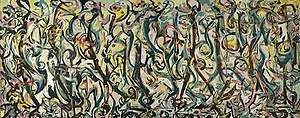Mural (1943)
| Mural | |
|---|---|
 | |
| Artist | Jackson Pollock |
| Year | 1943 |
| Type | Oil and casein on canvas |
| Location | University of Iowa Museum of Art, Iowa City |
Mural is a large painting by American artist Jackson Pollock. Although signed and dated 1943, the signature and date were not added until 1947, and the work was probably completed in early 1944,. It was made with oil paint (and an off-white water-based paint) on linen, and is Pollock's largest canvas, measuring 2.43 by 6.04 metres (8 ft 0 in × 19 ft 10 in). The work was commissioned by Peggy Guggenheim for the long entrance hall of her townhouse at 155 East 61st Street in New York City.
The work marks an important transitional moment in Pollock's artistic career, from his earlier works of surrealist abstraction towards action painting. It has been held by the University of Iowa Museum of Art since 1951.
Background
In 1943, Pollock had recently come to the end of a period working for the Federal Art Project, and was working at the Museum of Non-Objective Painting (later the Solomon R. Guggenheim Museum). The talent displayed by his small early paintings was recognised by Howard Putzel, who introduced him to Guggenheim. She was an art collector and dealer, and Pollock signed a contract with her gallery in July 1943 under which he would be paid $150 per month as a retainer, to be set against any proceeds from the sale of his artworks.
Mural was Pollock's first commission. Guggenheim first considered asking for a mural to be painted on the wall, but Marcel Duchamp suggested that it should be painted on canvas so it could be moved. Guggenheim bought an oversize canvas of Belgian linen and gave it to Pollock, but otherwise gave him no direction or instructions, and Pollock was simply asked to paint whatever he wished.
The mural was intended to be completed before a planned exhibition of his works opened in November 1943, but he continued to stare at a blank canvas, saying he was "blocked". Eventually, it was conventionally said, around 1 January 1944, he began frenetic work, completing the entire work in one day. A wall had to be removed to allow the large canvas to be installed.
Description
Mural is a largely abstract work with the suggestion of several human figures walking, or possibly birds, or letters and numbers, in broad swirls of black and white, cerulean blue, cadmium yellow, and umber, with touches of phthalocyanine green and blue. Most of the paint was applied with a brush, but some appears to have been splashed on. It combines influences from artists such as Thomas Hart Benton, Albert Pinkham Ryder and El Greco, and Mexican mural artists such as David Alfaro Siqueiros.
Reception
The importance of Mural was recognised immediately. The art critic Clement Greenberg wrote: "I took one look at it and I thought, 'Now that's great art,' and I knew Jackson was the greatest painter this country had produced."
After Guggenheim moved to Venice in 1947, she arranged with Lester Longman to donate the work to the University of Iowa. It was shipped to Iowa in 1951, where it is still held by the University of Iowa Museum of Art.
Conservation
The condition of the work had deteriorated by the 1970s, with the canvas sagging due to a weak stretcher and paint starting to flake off. The University of Iowa relined the painting in 1973, adding a second canvas with a wax adhesive, and also replacing the stretcher and varnishing the surface to stabilise the paint.
The painting was sent to the J. Paul Getty Museum in Los Angeles for 18 months from 2012 to 2014 to be fully conserved. The varnish was removed, and the stretcher was replaced again, this time with a curved stretcher that respects the sagged shape of the canvas. This conservation work revealed several layers of dried oil paints, without the distinct colours being swirled together, suggest that the work was not in fact completed in one day as had previously been thought, but rather was completed over a period of weeks, and was left to dry for several days between each session. However, the use of a quicker-drying white water-based casein house paint to add finishing touches to the upper layer suggests the painting may have been completed in hurry. Almost all of the drips of the thickly-applied paint flow in one direction, indicating that the work was mostly painted in an upright position with a brush. However, thin strands of pink indicate that some paint was applied using Pollock's famous "drip" action painting technique, in which the medium is laid horizontally on the floor.
The restored painting was exhibited at the Peggy Guggenheim Museum in Venice in 2015. Its value was estimated in 2016 at around $140 million.
References
- Jackson Pollock's Mural, Getty Museum
- Mural, University of Iowa Museum of Art.
- Jackson Pollock, Mural, Khan Academy
- The Myth of Jackson Pollock, Peggy Guggenheim, and the Masterpiece Created in One Night, Artsy Editorial, Abigail Cain, 12 September 2016
- Jackson Pollock's Mural, Energy Made Visible, David Anfam, Thames & Hudson
- Jackson Pollock, the one-man tornado who spattered his way to fame, The Guardian, Jonathan Jones, 24 April 2015
- Jackson Pollock's Mural: Energy Made Visible, Peggy Guggenheim Collection, April 23 – November 16, 2015
- Mural, 1943 by Jackson Pollock